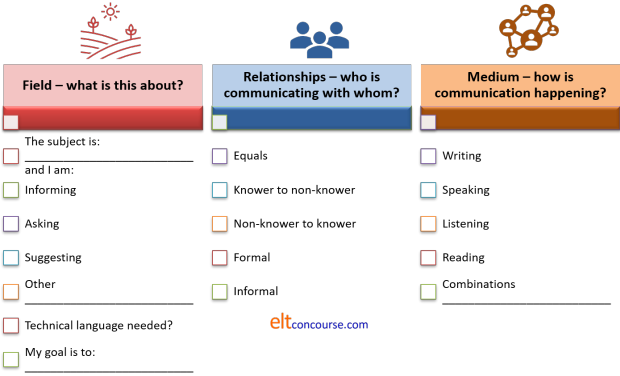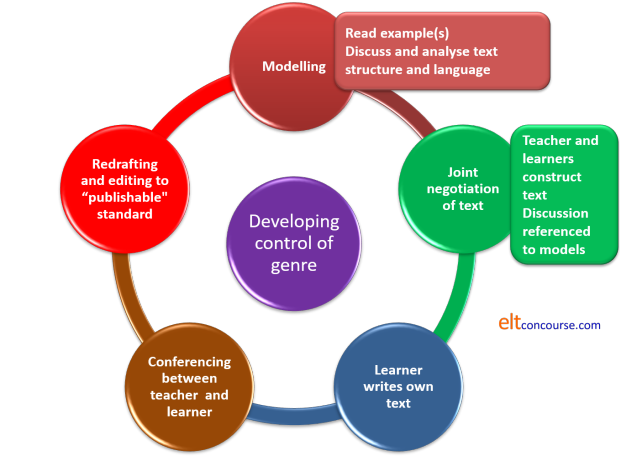Using a genre approach


If you haven't followed
the first guide to genre, you should do so now
and then come back to this guide for the teaching implications.
Now that we have reviewed the essential
structure of a range of common genres or text types, we need to think
about how this knowledge helps us to help our learners read more
effectively and write more powerfully.
- Reading: because knowledge of text types and structure allow readers to identify the text's purpose and locate the information they need as well as being able to predict what comes next.
- Writing: because knowledge of how text types are structured according to purpose will allow learners to write in a way that impresses the reader and gets the message across conventionally. Knowledge of genres structure is power.
One of the skills readers need is knowledge of generic structure.
This is sometimes called schematic genre knowledge.
Here are some teaching ideas.
 |
Field, Tenor and Mode: alerting learners |
If you have followed the first guide to genre, you will be aware
of the need to identify the context of situation of any text,
written or spoken. Your learners, too, need to be aware
although perhaps not in the same terms so a simple way to alert them
to what the language is doing and why it is the way it is
through
a simple questionnaire which can be inserted into a lesson at any
appropriate time.
It looks like this:

Not all these categories will be appropriate for all skills
lessons but most of them will. Do not assume that your
learners know what they are doing.
A form like this will take about three minutes to complete (and
people get even quicker with practice). If the time is used to
make sure that people know what they are doing, why they are doing
it and with whom, it will be time well spent.
You can, of course, do this as a whole-class exercise (which may be
wise the first time) but it is more effective in raising awareness
if it is done individually or in the pairs or groups that people
will be working in.
There is a little more detail in the guide to teaching skills,
linked below.
 |
Matching purpose to text stage |
Match the bits of the text on the left with the purpose of each section on the right. You can select any text that is appropriate for the level and falls within the same genre (in this case, Recount).
| Dear Mr Smith, I'm sorry I was so late to your class yesterday and caused a problem in the group but there was a good reason. |
Coda |
| On my way back
from lunch, I saw two school kids mucking about at the side of
the railway line which runs across the back of the school.
One of them seemed to be trying to throw stones onto the tracks.
Of course, I went over to them and asked them what they were
doing. They both said, "Nothing!", of course, and I had no proof so there was nothing I thought I could do so I started to walk away. Just as I was coming to the school gate, I heard a loud bang behind me and when I looked, I could see that one of the kids had thrown a bit of concrete over the fence and it was resting very close to the track. I ran back to the fence and looked over and saw that the concrete could possibly be hit by a passing train. I shouted at the kids and told them how stupid they'd been and that I was going to get the police. They were pretty frightened and ran off down the road. I wanted to chase after them but that would mean I could do nothing about the danger so I decided to call the police instead and tell them what had happened. They told me to wait where I was until they arrived, which they did very quickly. As soon as they saw the danger, one of them climbed over the fence and removed the piece of concrete. |
Orientation |
| Anyway, the police kept me a long time after that because they wanted a statement from me of what I'd seen and a description of the kids. I'm afraid that all took rather a long time and made me really late. | Record |
| I'm sorry again to
have been so late and caused the problems with the group but I
don't think there was anything else I could have done in the
circumstances. I do hope you understand. |
Reorientation |
Task 1 with this text is
to recognise that it comes in four distinct stages and then to analyse
what the stages do. The metalanguage (on the right) is probably
not necessary but learners do need to have some way to describe what's
happening.
The right answer, by the way, is Orientation >
Record of events > Reorientation > Coda.
The next step would be to give the learners a text and get them to
identify and label the function of each bit without the prompts on the
right.
 |
Following upThere are lots of follow-up activities you can do with a text in any genre: |
-
Look for the language
- focus the learners on the types of verbs in each section. They should notice that the orientation and coda contain what are called projecting processes (like, think, hope etc.) and relational processes with verbs like be and cause. The other two sections contain different sorts of verbs describing what actions were taken and so on. These are called material processes. If you want to learn about verbs as processes, see the guide to verb processes on this site, linked below.
- Look for what are called circumstances (or adverbials in some grammars). These are things like on my way back, yesterday, very quickly, in the circumstances, just as etc. Recounts are rich in these because the reader needs to be kept in the picture. If you want to learn about circumstances, see the guide to circumstances on this site, linked below.
-
Use it as a model
- Everyone has some sort of anecdote they can tell or write but learners of English need to know how to structure the text.
- After you have done stage 1, you can get the learners to make notes about their own anecdote, dividing what happened into the four sections. First they write the Orientation and then sequence the events. Then they need to look at the example of Reorientation and write that before writing the Coda. A mistake learners often make, especially if they come from cultures in which the structure differs from English, is to start with a Coda, tell the story and then orientate the reader.
Re-ordering
A simple but effective way of raising
awareness of text staging is to take an example such as a Discussion
text and chop it up separating the various stages into discrete parts:
statement of issue, arguments for, arguments against and personal
evaluation (if it exists).
Then do the same with an Exposition and see if the learners can spot the
differences in staging and structure. That might help them to
avoid writing an Exposition when they need a Discussion and vice
versa.
Of course, the exercise above can also be done with these genres but the
verbal structure and circumstances will vary. In particular, you
should focus on modal auxiliary verbs. Expositions tend to contain lots of
should, must, be prohibited, can't, ought etc. while
discussions are toned down with, e.g., arguably, it might be that
..., may and so on.
Circumstances in Expositions tend to be more extreme and terms such as
everywhere, always, invariably, massively, most of ... etc.
while Discussions use more hedged expressions such as often, much,
some etc.
Exploiting theme and rheme
We saw in the last section how the theme of one clause will generate
a rheme which will, in turn, become the theme of a subsequent (although
not necessarily the next) clause.
For example, notice how, in the Recount above, the theme
On my way back from lunch
leads to the rheme
I saw two school kids
mucking about
and that this rheme becomes the theme
of the next bit
One of them ...
I and
the kids recur later as
themes of subsequent clauses with their own rhemes. The
connections are made for the reader with a number of discourse devices
such as pronoun substitution (they
for the kids), repetition (I
occurs frequently), synonymy (danger
for piece of concrete) and so
on. How this is done exactly is a topic for the guide to cohesion
(linked below) but it
can be exploited in the classroom to help learners notice the structure
and duplicate it.
Underlining the devices and getting learners to identify the
connections is a good beginning but we can do more:
- Try getting learners to duplicate the structure of the first two
theme-rheme connections by saying or writing about what happened to
them in an anecdote. Then they can set up the first theme with a
circumstance like
On my way back from lunch
and then follow it with a rheme concerning what they saw / heard / felt etc. and then use that rheme to form the theme of the next clause and so on. - Play a round-the-class retelling of a familiar story (fables are good) in which the next learner has to use the last learner's rheme to form a new theme.
- Look at the theme-rheme structure of a simple Discussion, Explanation or Exposition and get the learners to identify which rhemes become themes later in the text and how the connections are made. In these genres, a common structure is for the main theme to recur frequently with a variety of rhemes only some of which will become themes of clauses. For an example of an Explanation text (with sequential events) to use, try this text from a reading lesson for B1 / B2 learners on Crime and Punishment. The lesson starts here (opening in a new tab) and the text is this with the words in red being the target lexical sets for the lesson:
John has had a long and interesting
criminal career.
He first broke the
law when he was only 16. He was
arrested by the police for vandalism
because he was caught painting graffiti
on the walls of his local underground station. After that, it just got
worse.
By the time he was twenty, John had convictions
for theft,
arson, drug dealing and
assault. He had already spent over a
year in institutions for young offenders.
At the age of twenty-two, however, his crimes
became even more serious. He was
arrested on two counts of burglary,
having broken into houses in North
London. He was also accused of resisting arrest and
assaulting a policeman. Although
John pleaded guilty, the
court took these
offences very seriously and John was
sentenced to ten years'
imprisonment.
However, while he was in prison, John
became a reformed character and he deeply regretted his earlier
life of crime. The prison
warders noticed John's change of heart
and recommended him for early release.
When he came out, John took a degree in
social work and became an advisor in schools. He travels around the
country talking to young people about the dangers of
crime and
drug dealing.
Notice how the main theme (John) leads to many rhemes and how the rhemes (crimes, the police, prison etc.) become, in turn, themes of subsequent clauses. If you can do this, so can your learners. And then they can go on to construct a believable and well connected (cohesive) biography of a real or imagined character.
In the guide to understanding generic structure and theme-rheme patterns for English for Academic Purposes, linked in the list of related guides at the end, the outline of a whole writing course to tackle the key issues is provided.
One area of grammar which can be explained with a good deal of precision and makes sense to many people by using the concepts of theme and rheme is the formation of the passive in English also linked in the list of related guides at the end.
 |
An overview of a genre approach to writing |
Here's a summary of the stages (some of which bear repeating) of the procedure for implementing a genre approach to writing skills in the classroom. Please don't try to do it all in a single lesson!

The system is explained slightly more fully in the guide to using such an approach in writing for English for Academic Purposes (linked below).
This is not the place to provide more
examples, many of which won't help you with your particular learners
and their needs, but you may like to go to the
pages for learners and
look at the reading lessons and the materials there.
Help yourself, but remember,
please, to credit this site.
| Related guides | |
| the first guide to genre | if you haven't followed this yet and some of the above has confused you |
| tense and genre | this guide is concerned with what some refer to as narrative tenses |
| teaching skills | this is the overview with links to guides to individual skills |
| genre in English for Academic Purposes | this has more detail but is linked primarily to EAP |
| theme and rheme | for a more detailed guide |
| verbal processes | the guide concerned with what verbs do and what text types they appear in |
| cohesion | for the mechanics of how texts are made cohesive |
| writing skills | the first of two guides |
| circumstances | the guide which covers the area |
| semantics | for a bit more on schemata activation |
| paragraph structure | for a guide to the conventional structuring of a paragraph in English |
| writing a paragraph | a lesson for B1/B2-level learners about how to write a paragraph |
| the passive | for more on how the uses of the passive in English can be explained by reference to theme and rheme structures |
